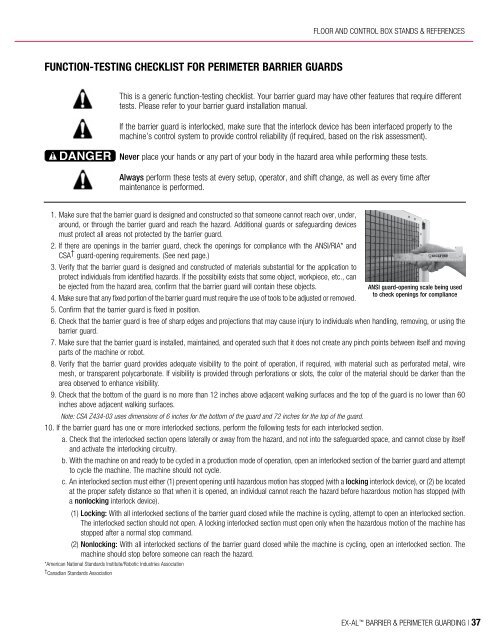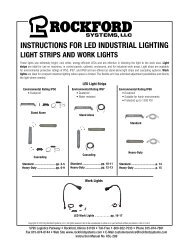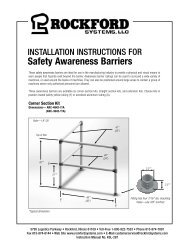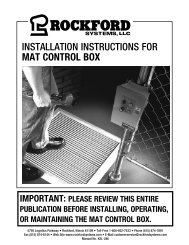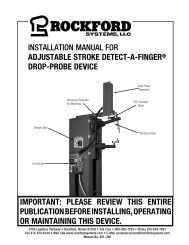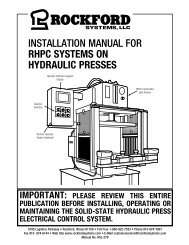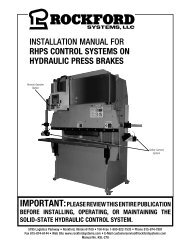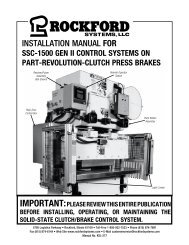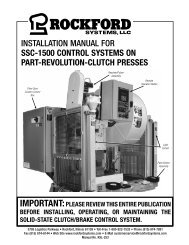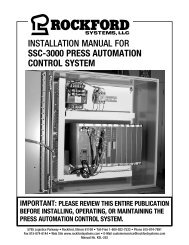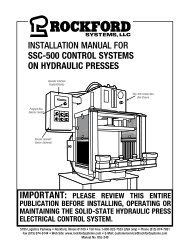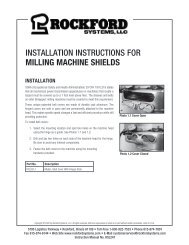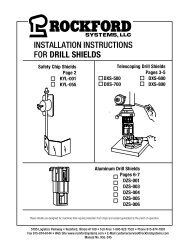Rockford Systems EX-AL (Extruded Aluminum) Barrier & Perimeter Guarding Catalog
Catalog that features a wide-range of safeguarding devices and other safety-related products for updating hazardous machinery and processes. These devices are designed for point-of-operation safeguarding as well as for auxiliary guarding and large work-envelope safeguarding. Some of the products in this catalog include presence-sensing devices, area scanning devices, tower light assemblies, Detect-A-Finger® drop-probe devices, and pressure sensitive safety mats. These products can be used to safeguard fabricating machines, metal-cutting machines, material handling equipment, woodworking machines, and more. These safeguarding devices are designed to meet or exceed the OSHA regulations and ANSI standards.
Catalog that features a wide-range of safeguarding devices and other safety-related products for updating hazardous machinery and processes. These devices are designed for point-of-operation safeguarding as well as for auxiliary guarding and large work-envelope safeguarding. Some of the products in this catalog include presence-sensing devices, area scanning devices, tower light assemblies, Detect-A-Finger® drop-probe devices, and pressure sensitive safety mats. These products can be used to safeguard fabricating machines, metal-cutting machines, material handling equipment, woodworking machines, and more. These safeguarding devices are designed to meet or exceed the OSHA regulations and ANSI standards.
Create successful ePaper yourself
Turn your PDF publications into a flip-book with our unique Google optimized e-Paper software.
FLOOR AND CONTROL BOX STANDS & REFERENCES<br />
FUNCTION-TESTING CHECKLIST FOR PERIMETER BARRIER GUARDS<br />
This is a generic function-testing checklist. Your barrier guard may have other features that require different<br />
tests. Please refer to your barrier guard installation manual.<br />
If the barrier guard is interlocked, make sure that the interlock device has been interfaced properly to the<br />
machine’s control system to provide control reliability (if required, based on the risk assessment).<br />
DANGER<br />
Never place your hands or any part of your body in the hazard area while performing these tests.<br />
Always perform these tests at every setup, operator, and shift change, as well as every time after<br />
maintenance is performed.<br />
1. Make sure that the barrier guard is designed and constructed so that someone cannot reach over, under,<br />
around, or through the barrier guard and reach the hazard. Additional guards or safeguarding devices<br />
must protect all areas not protected by the barrier guard.<br />
2. If there are openings in the barrier guard, check the openings for compliance with the ANSI/RIA* and<br />
CSA † guard-opening requirements. (See next page.)<br />
3. Verify that the barrier guard is designed and constructed of materials substantial for the application to<br />
protect individuals from identified hazards. If the possibility exists that some object, workpiece, etc., can<br />
be ejected from the hazard area, confirm that the barrier guard will contain these objects.<br />
ANSI guard-opening scale being used<br />
to check openings for compliance<br />
4. Make sure that any fixed portion of the barrier guard must require the use of tools to be adjusted or removed.<br />
5. Confirm that the barrier guard is fixed in position.<br />
6. Check that the barrier guard is free of sharp edges and projections that may cause injury to individuals when handling, removing, or using the<br />
barrier guard.<br />
7. Make sure that the barrier guard is installed, maintained, and operated such that it does not create any pinch points between itself and moving<br />
parts of the machine or robot.<br />
8. Verify that the barrier guard provides adequate visibility to the point of operation, if required, with material such as perforated metal, wire<br />
mesh, or transparent polycarbonate. If visibility is provided through perforations or slots, the color of the material should be darker than the<br />
area observed to enhance visibility.<br />
9. Check that the bottom of the guard is no more than 12 inches above adjacent walking surfaces and the top of the guard is no lower than 60<br />
inches above adjacent walking surfaces.<br />
Note: CSA Z434-03 uses dimensions of 6 inches for the bottom of the guard and 72 inches for the top of the guard.<br />
10. If the barrier guard has one or more interlocked sections, perform the following tests for each interlocked section.<br />
a. Check that the interlocked section opens laterally or away from the hazard, and not into the safeguarded space, and cannot close by itself<br />
and activate the interlocking circuitry.<br />
b. With the machine on and ready to be cycled in a production mode of operation, open an interlocked section of the barrier guard and attempt<br />
to cycle the machine. The machine should not cycle.<br />
c. An interlocked section must either (1) prevent opening until hazardous motion has stopped (with a locking interlock device), or (2) be located<br />
at the proper safety distance so that when it is opened, an individual cannot reach the hazard before hazardous motion has stopped (with<br />
a nonlocking interlock device).<br />
(1) Locking: With all interlocked sections of the barrier guard closed while the machine is cycling, attempt to open an interlocked section.<br />
The interlocked section should not open. A locking interlocked section must open only when the hazardous motion of the machine has<br />
stopped after a normal stop command.<br />
(2) Nonlocking: With all interlocked sections of the barrier guard closed while the machine is cycling, open an interlocked section. The<br />
machine should stop before someone can reach the hazard.<br />
*American National Standards Institute/Robotic Industries Association<br />
† Canadian Standards Association<br />
<strong>EX</strong>-<strong>AL</strong> BARRIER & PERIMETER GUARDING | 37


